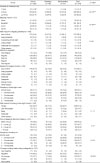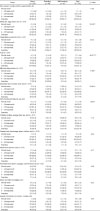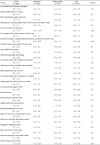1. Kim HK, Kim JH. Food habits and nutrition knowledge of college students residing in the dormitory in Ulsan area. J Korean Soc Food Sci Nutr. 2005; 34(9):1388–1397.
2. Jung EH. Dietary behavior by residence types of female college students in Chungbuk area. Korean J Community Living Sci. 2005; 16(4):115–123.
3. Seymour M, Hoerr SL, Huang YL. Inappropriate dieting behaviors and related lifestyle factors in young adults: Are college students different? J Nutr Educ. 1997; 29(1):21–26.

4. Ahn HS. Iron nutritional status of female college students in Seoul area. J Living Cult Res. 1999; 13(1):119–131.
5. Shin JR, Ly SY. Dietary habits and factors related to lifestyles in constipated female students. Korean J Community Nutr. 2003; 8(5):675–688.
6. Moses N, Banilivy M, Lifshitz F. Fear of obesity among adolescent girls. Pediatrics. 1989; 83(3):393–398.
7. Park MY, Choi SY, Kim SH. A study of the factors affecting blood iron status in female college students. J East Asian Soc Diet Life. 2012; 22(4):463–472.
8. Chung SH, Chang KJ. A comparison between food and nutrition major, and non-major, female university students in terms of their nutrient intake and hematological status, with an emphasis on serum iron. Korean J Nutr. 2002; 35(9):952–961.
9. Kim MH, Kim H, Lee WK, Kim SJ, Yeon JY. Food habits and dietary behavior related to using processed food among male college students residing in dormitory and self-boarding in Gangwon. Korean J Community Nutr. 2013; 18(4):372–385.

10. Park ES. A study of the body weight perception, living habits and food intake frequency by residence type in female college students of Chenbuk area. Korean J Hum Ecol. 2013; 22(1):215–229.
11. Lee YN, Lee JS, Ko YM, Woo JS, Kim BH, Choi H. Study on the food habits of college students by residence. Korean J Community Nutr. 1996; 1(2):198–200.
12. Seo BM. A study on female college students' dietary habits and food frequency at the convenience store according to their residential types [master's thesis]. Yonsei University;2017.
13. Park EH, Jung HK, Kim YA. Dietary behavior of university students in Incheon area according to the residence types. J East Asian Soc Diet Life. 2009; 19(6):909–920.
14. Kim SJ, Bu SY, Choi MK. Preference and the frequency of processed food intake according to the type of residence of college students in Korea. Korean J Community Nutr. 2015; 20(3):188–196.

15. Kim MJ, Rho SN. Relationship among nutrient intake, indices of anemia and serum lipids in Korean college women. J East Asian Soc Diet Life. 1999; 9(3):302–314.
16. Choi KS, Shin KO, Huh SM, Chung KH. Analysis of dietary habits by MDA (mini dietary assessment) score and physical development and blood parameters in female college students in Seoul area. J East Asian Soc Diet Life. 2009; 19(6):856–868.
17. Brevard PB, Ricketts CD. Residence of college students affects dietary intake, physical activity, and serum lipid levels. J Am Diet Assoc. 1996; 96(1):35–38.

18. Garner DM, Garfinkel PE. The eating attitudes test: an index of the symptoms of anorexia nervosa. Psychol Med. 1979; 9(2):273–279.

19. Rhee MK, Lee YH, Park SH, Sohn CH, Chung YC, Hong SK, et al. A standardization study of the Korean version of Eating Attitudes Test-26 I: Reliability and factor analysis. Korean J Psychosom Med. 1998; 6(2):155–175.
20. Ministry of Health & Welfare, Korea Centers for Disease Control and Prevention. Korean National Health and Nutrition Examination Survey 2016. Sejong: Ministry of Health & Welfare;2017.
21. Choi KS, Shin KO, Huh SM, Chung KH. Comparison of nutritional and physical status according to the residential type among college women in Seoul women's university and Sahmyook university. Korean J Nutr. 2010; 43(1):86–96.
22. Yang J, Sohn CM. Nutritional status and dietary quality by their residing types in college students. J Korean Living Sci Assoc. 2009; 18(4):959–970.

23. Lee JS, Chung HJ. A study of female college students' breakfast behavior and ideal breakfast type. Korean J Diet Cult. 2001; 16(4):378–387.
24. Choe JS, Ji SM, Paik HY, Hong SM. A study on the eating habits and dietary consciousness of adults in urban area. J Korean Soc Food Sci Nutr. 2003; 32(7):1132–1146.
25. Yang IS. Enhancing the school foodservice management through national school breakfast program. J Korean Diet Assoc. 1997; 3(2):223–238.
26. Lee JW, Hyun W, Kwak CS, Kim C, Lee HS. Relationship between the number of different food consumed and nutrient intakes. Korean J Community Nutr. 2000; 5:Suppl. 297–306.
27. Joo EJ, Park ES. Effect of sex and obese index on breakfast and snake intake in elementary school students. Korean J Diet Cult. 1998; 13(5):487–496.
28. Jun YS, Choi MK, Bae YJ. Night eating and nutrient intake status according to residence type in university students. J Korean Soc Food Sci Nutr. 2015; 44(2):216–225.

29. Choi JG, Shin MK, Seo ES. A study on self-evaluated obesity and food habits by residence type of college students in Ik-San area. J Korean Living Sci Assoc. 2004; 13(1):97–110.
30. Kim KH. A study of the dietary habits, the nutritional knowledge and the consumption patterns of convenience foods of university students in the Gwangju area. Korean J Community Nutr. 2003; 8(2):181–191.
31. Lee JW. Effects of frequent eating-out breakfast skipping on body mass index and nutrients intake of working male adults: analysis of 2001 Korea national health and nutrition survey data. Korean J Community Nutr. 2009; 14(6):789–797.
32. Allison KC, Ahima RS, O'Reardon JP, Dinges DF, Sharma V, Cummings DE, et al. Neuroendocrine profiles associated with energy intake, sleep, and stress in the night eating syndrome. J Clin Endocrinol Metab. 2005; 90(11):6214–6217.

33. Jung HJ, Park KH, Cho YG, Cho JJ, Park YJ, Song HJ, et al. Night eating tendency and related health risk factors. Korean J Obes. 2006; 15(2):98–105.
34. Nam HJ, Kim YS. Study on association between risk of eating disorder and self-esteem on body image. Korean J Food Nutr. 2005; 18(2):115–126.
35. Lee HS, Lee JA, Paik JJ. A study of food habits, physical status and related factors of college students in Chuncheon. Korean J Community Nutr. 1998; 3(1):34–43.
36. Hong SM, Bak KJ, Jung SH, Oh KW, Hong YA. A study on nutrient intakes and hematological status of female college students of Ulsan city. Korean J Nutr. 1993; 26(3):338–346.
37. Byun KW. A study on the relationship between levels of serum lipids and food habits of college students. Korean J Food Nutr. 1994; 7(4):284–296.
38. Lee J, Lee HO, Yim JE, Kim YS, Choue RW. Effects of medical nutrition therapy on changes of anthropometric measurement, dietary pattern and blood parameters in over weight or obese women. Korean J Nutr. 2005; 38(6):432–444.





 PDF
PDF ePub
ePub Citation
Citation Print
Print







 XML Download
XML Download